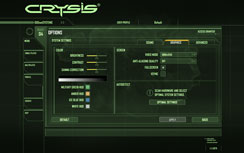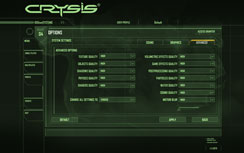XFX ATI Radeon HD 4770 512MB
Written by Antony Leather
May 27, 2009 | 10:57
Tags: #4770 #4850 #4870 #4890 #9800-gtx #evaluation #graphics-card #gts-250 #gtx-275 #performance #radeon #review #rv740

Crysis
Publisher: Electronic ArtsCrysis is seen by many as the poster boy for DirectX 10 and it will make your system cry, quite literally – it’s a monster! It doesn’t come as much of a surprise then, that the graphics are something special – they’re above and beyond anything we’ve ever seen in a PC game.
We tested the game using the 64-bit executable under DirectX 10 mode with the 1.21 patch applied. We used a custom timedemo recorded from the Laws of Nature level which is more representative of gameplay than the built-in benchmark that renders things much faster than you're going to experience in game. We found that around 27-33 fps in our custom timedemo was sufficient enough to obtain a playable frame rate through the game. It's a little different to other games in that the low frame rates still appear to be quite smooth.
We set all of the in-game details to High and forced 8x anisotropic filtering in the driver menu as there is currently no support for it in game. We tested at 1,280 x 1,024, using 0x, 2x and 4x anti-aliasing, 1,680 x 1,050 using 0x and 4xAA, and 1,920 x 1,200 using 0x and 4xAA. By extensively testing using anti-aliasing in very high resolutions in conjunction to High quality, we'll be pushing these mid range cards to the limit.
Crysis
1,280 x 1,024 0xAA 16xAF, DirectX 10, High Quality
- Nvidia GeForce GTS 250 512MB
- ATI Radeon HD 4850 512MB
- Nvidia GeForce 9800 GT 512MB
- XFX ATI Radeon HD 4770 512MB
- Gigabyte ATI Radeon HD 4770 512MB
- ATI Radeon HD 4770 512MB
- XFX GeForce 9600 GSO XXX Edition 384MB
- ATI Radeon HD 4830 512MB
-
-
39.9
-
22.0
-
-
-
33.4
-
17.0
-
-
-
29.9
-
16.0
-
-
-
29.5
-
15.0
-
-
-
29.3
-
15.0
-
-
-
29.2
-
15.0
-
-
-
26.2
-
15.0
-
-
-
23.9
-
12.0
-
0
10
20
30
40
Frames Per Second
-
Average
-
Minimum
Crysis
1,280 x 1,024 2xAA 16xAF, DirectX 10, High Quality
- Nvidia GeForce GTS 250 512MB
- ATI Radeon HD 4850 512MB
- Gigabyte ATI Radeon HD 4770 512MB
- Nvidia GeForce 9800 GT 512MB
- ATI Radeon HD 4770 512MB
- XFX ATI Radeon HD 4770 512MB
- ATI Radeon HD 4830 512MB
- XFX GeForce 9600 GSO XXX Edition 384MB
-
-
32.5
-
20.0
-
-
-
28.3
-
14.0
-
-
-
26.0
-
13.0
-
-
-
25.9
-
17.0
-
-
-
25.8
-
13.0
-
-
-
25.8
-
13.0
-
-
-
21.8
-
11.0
-
-
-
21.7
-
12.0
-
0
5
10
15
20
25
30
35
Frames Per Second
-
Average
-
Minimum
Crysis
1,280 x 1,024 4xAA 16xAF, DirectX 10, High Quality
- Nvidia GeForce GTS 250 512MB
- ATI Radeon HD 4850 512MB
- Nvidia GeForce 9800 GT 512MB
- XFX ATI Radeon HD 4770 512MB
- Gigabyte ATI Radeon HD 4770 512MB
- ATI Radeon HD 4770 512MB
- ATI Radeon HD 4830 512MB
-
-
29.3
-
17.0
-
-
-
25.6
-
12.0
-
-
-
23.8
-
12.0
-
-
-
23.7
-
11.0
-
-
-
23.3
-
11.0
-
-
-
23.2
-
11.0
-
-
-
20.2
-
10.0
-
0
5
10
15
20
25
30
Frames Per Second
-
Average
-
Minimum
Crysis
1,680 x 1,050 0xAA 16xAF, DirectX 10, High Quality
- Nvidia GeForce GTS 250 512MB
- ATI Radeon HD 4850 512MB
- Nvidia GeForce 9800 GT 512MB
- ATI Radeon HD 4770 512MB
- XFX ATI Radeon HD 4770 512MB
- Gigabyte ATI Radeon HD 4770 512MB
- XFX GeForce 9600 GSO XXX Edition 384MB
- ATI Radeon HD 4830 512MB
-
-
31.0
-
19.0
-
-
-
25.4
-
14.0
-
-
-
24.5
-
15.0
-
-
-
23.3
-
12.0
-
-
-
22.7
-
12.0
-
-
-
22.3
-
12.0
-
-
-
20.1
-
11.0
-
-
-
19.2
-
10.0
-
0
5
10
15
20
25
30
35
Frames Per Second
-
Average
-
Minimum
Crysis
1,680 x 1,050 4xAA 16xAF, DirectX 10, High Quality
- Nvidia GeForce GTS 250 512MB
- ATI Radeon HD 4850 512MB
- XFX ATI Radeon HD 4770 512MB
- Gigabyte ATI Radeon HD 4770 512MB
- Nvidia GeForce 9800 GT 512MB
- ATI Radeon HD 4770 512MB
- ATI Radeon HD 4830 512MB
-
-
21.7
-
11.0
-
-
-
20.1
-
10.0
-
-
-
19.0
-
9.0
-
-
-
18.9
-
9.0
-
-
-
18.5
-
10.0
-
-
-
18.5
-
9.0
-
-
-
16.1
-
8.0
-
0
5
10
15
20
Frames Per Second
-
Average
-
Minimum
Crysis
1,920 x 1,200 0xAA 16xAF, DirectX 10, High Quality
- Nvidia GeForce GTS 250 512MB
- ATI Radeon HD 4850 512MB
- Gigabyte ATI Radeon HD 4770 512MB
- ATI Radeon HD 4770 512MB
- Nvidia GeForce 9800 GT 512MB
- ATI Radeon HD 4830 512MB
- XFX GeForce 9600 GSO XXX Edition 384MB
- XFX ATI Radeon HD 4770 512MB
-
-
25.1
-
15.0
-
-
-
22.6
-
13.0
-
-
-
21.0
-
12.0
-
-
-
20.5
-
11.0
-
-
-
19.8
-
12.0
-
-
-
17.3
-
9.0
-
-
-
16.8
-
9.0
-
-
-
22.3
-
12.0
-
0
5
10
15
20
25
Frames Per Second
-
Average
-
Minimum
Crysis
1,920 x 1,200 4xAA 16xAF, DirectX 10, High Quality
- Nvidia GeForce GTS 250 512MB
- ATI Radeon HD 4850 512MB
- Gigabyte ATI Radeon HD 4770 512MB
- XFX ATI Radeon HD 4770 512MB
- ATI Radeon HD 4770 512MB
- Nvidia GeForce 9800 GT 512MB
- ATI Radeon HD 4830 512MB
-
-
23.8
-
11.0
-
-
-
20.0
-
11.0
-
-
-
18.6
-
10.0
-
-
-
18.5
-
10.0
-
-
-
18.1
-
9.0
-
-
-
16.6
-
8.0
-
-
-
16.0
-
8.0
-
0
5
10
15
20
25
Frames Per Second
-
Average
-
Minimum
Performance was pretty dire for all the HD 4770s and there was very little between all three due to the identical clock speeds. To get playable frame rates even at 1,280 x 1,024, you'll need to spend some time tweaking the game and you'll definitely need to disable AA and probably run in DirectX 9 mode too, especially if you have a higher resolution monitor.
However, the XFX HD 4770 512MB was noticeably faster than the XFX GeForce 9600 GSO XXX Edition 384MB and ATI Radeon HD 4830 512MB which only save you between £10 and £20 but you'll need an Nvidia GeForce GTS 250 512MB before you start to approach decent frame rates in our benchmarks.











Want to comment? Please log in.